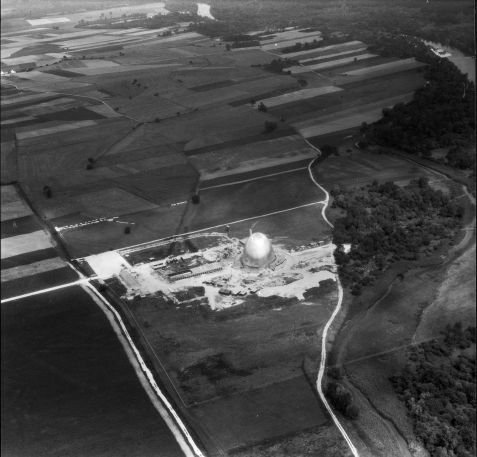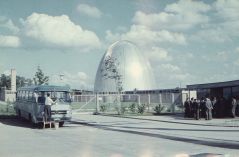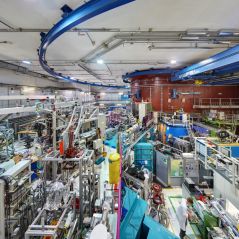MLZ is a cooperation between:
 > Technische Universität München
> Technische Universität München > Helmholtz-Zentrum Hereon
> Helmholtz-Zentrum Hereon
 > Forschungszentrum Jülich
> Forschungszentrum Jülich
MLZ is a member of:
 > LENS
> LENS > ERF-AISBL
> ERF-AISBL
MLZ on social media:

MLZ (eng)
Lichtenbergstr.1
85748 Garching
27.10.2017
The “Atomic Egg” celebrates its 60th birthday

When the research reactor was built in 1957, it was only surrounded by agricultural areas, but soon, it triggered the development of a cutting edge research campus. © Archiv Stadt Garching
On October 31, 1957, the Munich research reactor FRM went online for the first time. Until 2000, the “Atomic Egg” of the Technical University of Munich (TUM) was a reliable provider of neutrons for basic research and medical applications. This year the facility is celebrating its 60th birthday with a special exhibition.
The planning and construction of the research reactor fell into the time of German reconstruction. It took just over one year from the time of the purchase resolution by the Bavarian Council of Ministers (July 6, 1956), to the start of construction work on the reactor (November 6, 1956) and the first produced neutrons on October 31, 1957. At the time, Bavaria edged ahead of Dresden in the competition to bring the first reactor into operation. Because of its egg-shaped dome, designed by the architect Gerhard Weber, the FRM was soon known simply as the Atomic Egg.
From cabbage farmland to a renowned research center
In the context of the United States’ program “Atoms for Peace,” Professor Heinz Maier-Leibnitz bought the reactor on behalf of the Bavarian state government. Maier-Leibnitz developed the Atomic Egg as a research institute with world-wide recognition that would soon operate on an equal footing with leading American researchers. From its inception, the Garching Atomic Egg has served basic research in physics and chemistry. The scientists developed technologies and standards that were later adopted at other research reactors: Neutron guides, for example, were invented at the Atomic Egg, as was backscattering spectrometry. Even the safety standards that the Garching operators developed in lieu of statutory provisions served as a reference for other reactors and later found their way into generally accepted rules. In addition to basic research, Prof. Maier-Leibnitz cared deeply about educating next-generation nuclear technology and science researchers who were in demand not only in Germany, but around the world. Maier-Leibnitz’s reputation, and ultimately the Nobel Prize for his student Dr. Rudolph Mößbauer, attracted numerous renowned physicists to Garching as guest professors. The Atomic Egg in the cabbage fields of Garching thus became the germ seed of a scientific campus that, today, is second to none in Europe.
New beginning with a modern, high-performance neutron source
The performance of the atomic egg was increased twice: from initially one megawatt heat to 2.5 megawatts in 1966 and then finally to 4 megawatts in 1968. However, in the 1980s the neutron density was no longer competitive internationally, which is why the scientists began planning a new research neutron source. The neutron source known as FRM II was designed to deliver a 100-fold higher neutron flux. On July 28, 2000, after approval was granted for FRM II, the Atomic Egg was shut down. It had produced neutrons for 43 years without failure and enabled tens of thousands of projects. The shell of the Atomic Egg, which is also found in the Garching city crest, is a listed historical structure. Work to gut and dismantle the interior has been in progress since 2014 to make the hall available for science and operation of FRM II in the future. A photo exhibition showcasing “60 Years of Neutron Research,” including a walk-in wooden model of the Atomic Egg, will be on display in the Museum Reich der Kristalle (Theresienstr. 41 in Munich) from November 6 to December 3, 2017.
Contact:
Prof. Dr. Winfried Petry
Wissenschaftlicher Direktor
Forschungs-Neutronenquelle
Heinz Maier-Leibnitz
Germany
Tel: 089/ 289-14965
Email: presse@frm2.tum.de
More information:
German brochure for the 40th anniversary of the atomic egg
Special photo exhibition in the Museum Reich der Kristalle
A photo exhibition showcasing “60 Years of Neutron Research,” including a walk-in wooden model of the Atomic Egg, will be on display in the Museum Reich der Kristalle (Theresienstr. 41 in Munich) from November 6 to December 3, 2017.
Related News
-
21.07.2017
Neutrons from Garching since 60 years
MLZ is a cooperation between:
 > Technische Universität München
> Technische Universität München > Helmholtz-Zentrum Hereon
> Helmholtz-Zentrum Hereon
 > Forschungszentrum Jülich
> Forschungszentrum Jülich
MLZ is a member of:
 > LENS
> LENS > ERF-AISBL
> ERF-AISBL
MLZ on social media:





